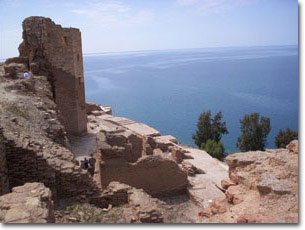|
 North
eastern shore of Lake Assad, 10 km from dam wall; Jaabar Castle uses a
central core of high ground, tightly circumscribed by defensive walls
and a ditch. However, the entrance gateway and ramp and much of the
largely brick walls are worth inspection. It once overlooked an
important crossing point on the Euphrates; it has gained in visual
impact with the encroachment of the waters of Lake Assad to the base of
the castle. The rise on which the castle stood is now an island joined
to the shore by a causeway. North
eastern shore of Lake Assad, 10 km from dam wall; Jaabar Castle uses a
central core of high ground, tightly circumscribed by defensive walls
and a ditch. However, the entrance gateway and ramp and much of the
largely brick walls are worth inspection. It once overlooked an
important crossing point on the Euphrates; it has gained in visual
impact with the encroachment of the waters of Lake Assad to the base of
the castle. The rise on which the castle stood is now an island joined
to the shore by a causeway.
It goes back in time to the Zengid, Ayyūbid and Mameluke periods in
northern Syria and to the build-up of Arab resistance to the Crusaders.
In an earlier attempt to dislodge the Crusaders, Zengi was killed
before its walls after a quarrel with a Frankish eunuch. 
The history of the castle is largely confined to the Zengid, Ayyūbid
and Mameluke periods in northern Syria and to the build-up of Arab
resistance to the Crusaders. Banu Numair tribe held the site before the
castle was built until taken by the Seljuq Sultan in 1087. During the
first Crusade in 1104, it was incorporated into the territory of the
Count of Edessa, however, fell to Zengi, the Atabeq (the commander of
the army) of Aleppo, in 1144 and the subsidiary fortress reverted to
the Arabs by 11479. The remains which are seen today date from the rule of Zengi's son Nūr
al-Din who, as his father's successor in Aleppo, fulfilled his vision
of bringing Syria under united Muslim rule by 1154. His rebuilding of
the castle began in 1168. It remained in Ayyūbid hands under Saladin
and his successors (1176 – 1260) but it fell victim to the repeated
Mongol waves whose incursions caused so much devastation between 1260
and 1400. 
The fabric is entirely brick in the upper levels, reflecting the
Mesopotamian tradition whose influence was strong in Syria at the time
of the Zengids (in Raqqa). The main parts of interest are the entrance
gateway and the corridor. The walls upper brick work has been restored
post-1972. On the broad summit, little remains above the ground except
for a fine brick cylindrical minaret which recalls others of the 12th
century in northern Syria probably erected by Nūr al Din. |


